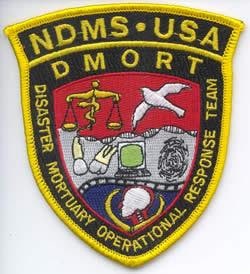by Pat Brewer
In 1997 it was time to set back and let my son Barry run the day-to-day operations of the funeral homes and let Yvonne and I travel and see the sights of the good old USA. I forgot one thing, that is to renew my license, which required 12 hours of CEU (continuing education unit) and it was time to renew. I had to find something that would give me the necessary units quickly. There was a conference in Ft Lauderdale that would work for the hours that I needed. I signed up and was on my way to Ft Lauderdale for the weekend. Little did I know that they were also recruiting for a new federal disaster unit called DMORT (Disaster Mortuary Operational Team).
Well, I was sort of retired and thought it would be interesting. So, I signed up. Little did I know that this would be such a full-time responsibility. This is some of the responsive tasks that I was involved in:
1. The Murrow building in Tulsa, Oklahoma was bombed. The destruction of the building was devastation but the lives that were lost included many children.
2. A ValuJet plane crashed in the Everglades of Florida with 110 souls on board, no survivors. We worked with the Miami Dade County Medical examiner for several months helping them identify as many of the remains as possible and arrangements for a burial of the unidentified ones, in a local cemetery.
3. Hurricane Floyd hit Tarboro NC. A dam broke and washed out the cemetery. We worked out of a non-air-conditioned warehouse and stayed in a Motel that had been flooded until the mold took over the building.
4. Sept. 11, 2001 New York World Trade Center
After New York, Gov. Bob Graham felt that Florida needed its own Disaster Group and we formed the FEMORS (Florida Emergency Mortuary Response System) and was fully funded and equipment is stored in the Orlando area including a truck and trailer that can go anywhere in the state in a short notice. It is now governed by the University of Florida.
5. Hurricane Ivan and Ervin hit the Florida coast. A lot of damage but very few deaths.
6. A crematory operator in Walker County, Ga was picking up bodies all over North Georgia for cremation. The cremains that were returned to the families were nothing but ashes from a woodpile fire in front of the crematory. When the Georgia Bureau of Investigation came to Walker County, we were called to help recover all of the over 200 bodies were found on the property and very difficult to identify.
7. Hurricane Katrina hit the Gulf coast doing heavy damage to Louisiana and Mississippi. Our responsibility was the Mississippi side and operated out of a hangar at the Biloxi Airport. We recovered over 200 remains that washed ashore and were found in areas that had been covered with floodwater. It was interesting watching Air Force one fly in several times a week to check and help with the damage.
8. The Dozier School for boys in Marianna, Fl closed and discovered a graveyard with over 50 unidentified bodies on the property. We used ground-penetrating radar to locate the graves and with permission from the State of Florida, we started the process in disinterment. Our work was with the University of South Florida forensic Anthropology class, to help to locate and recover the bodies of the 55 boys that had been buried there during the 70 plus years of the existence of the school. The first boy we recovered was from Brooksville.
After 20 plus years and working 12 hours per day 7 days a week, I think this is a job for younger people.
***
Sept. 11, 2001
Sept 11, 2001, two aircraft hit the World Trade Towers in New York, leaving thousands of remains in the aftermath. I was in the funeral home in Brooksville when the message came in, that we were going to be deployed to New York. Then the president grounded all aircraft and 7 of the DMORT (Disaster Mortuary Operational Response Team) a federal disaster response team from the southeastern United States met in Orlando and traveled to New York in a rented van. After 22 hours on the road, we arrived at an Air Force Base just north of New York City for a few hours’ sleep before being taken to the Hotel in New York. We worked 12-hour shifts at the medical examiner’s office. My responsibility was to control the 20 refrigerated trailers that remains were stored in after they went through the identification process. After several months many of the remains had been identified and returned to their families and we were able to shut down the trailers and the ME office could return to normal.

